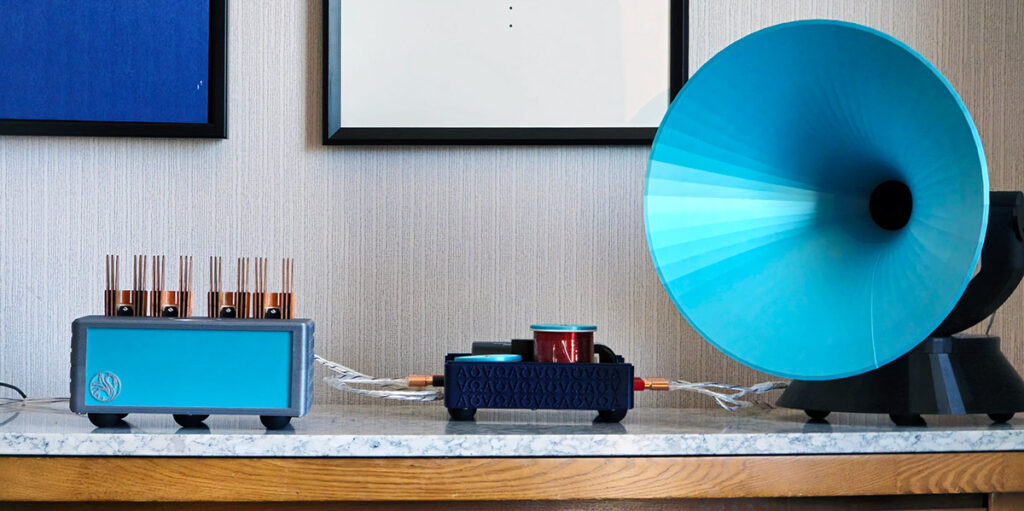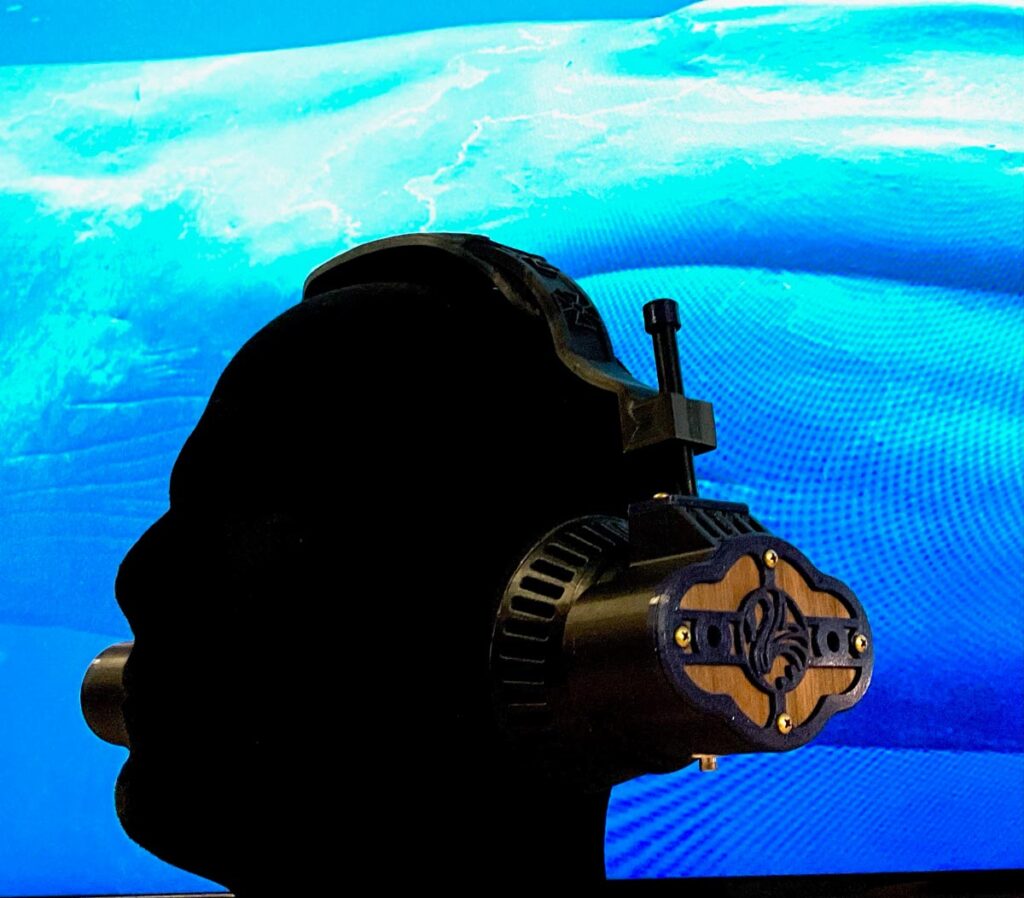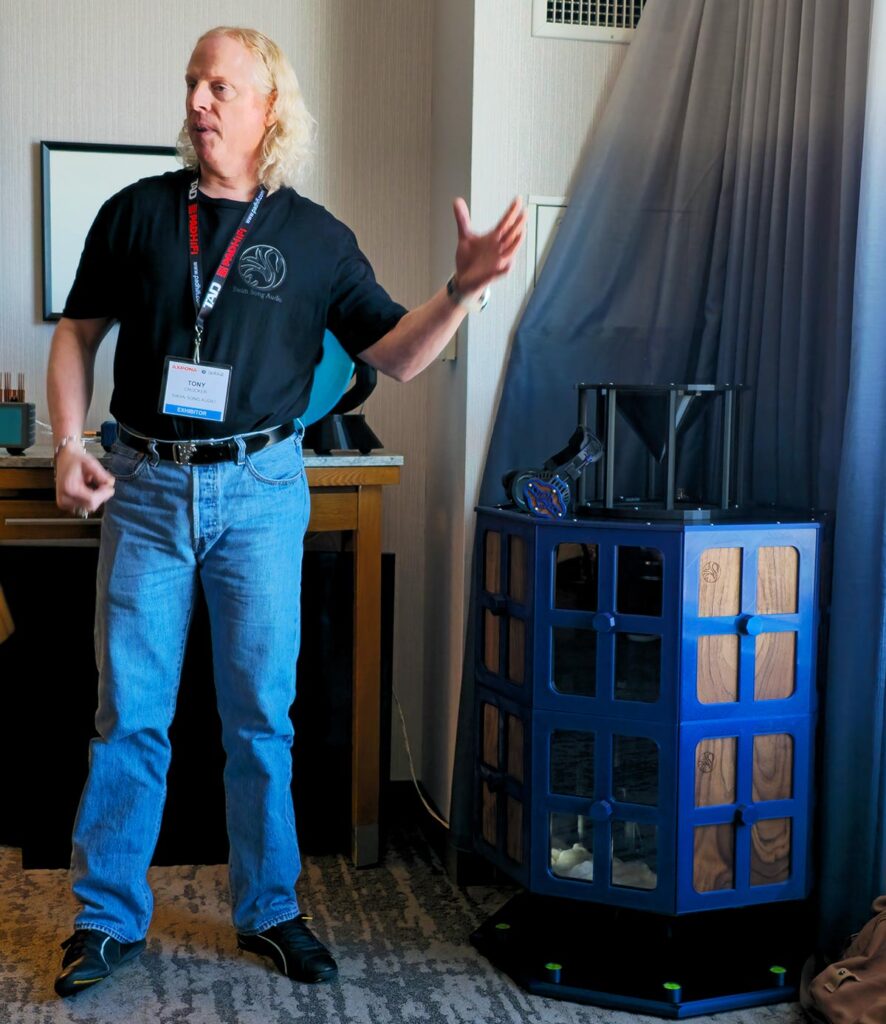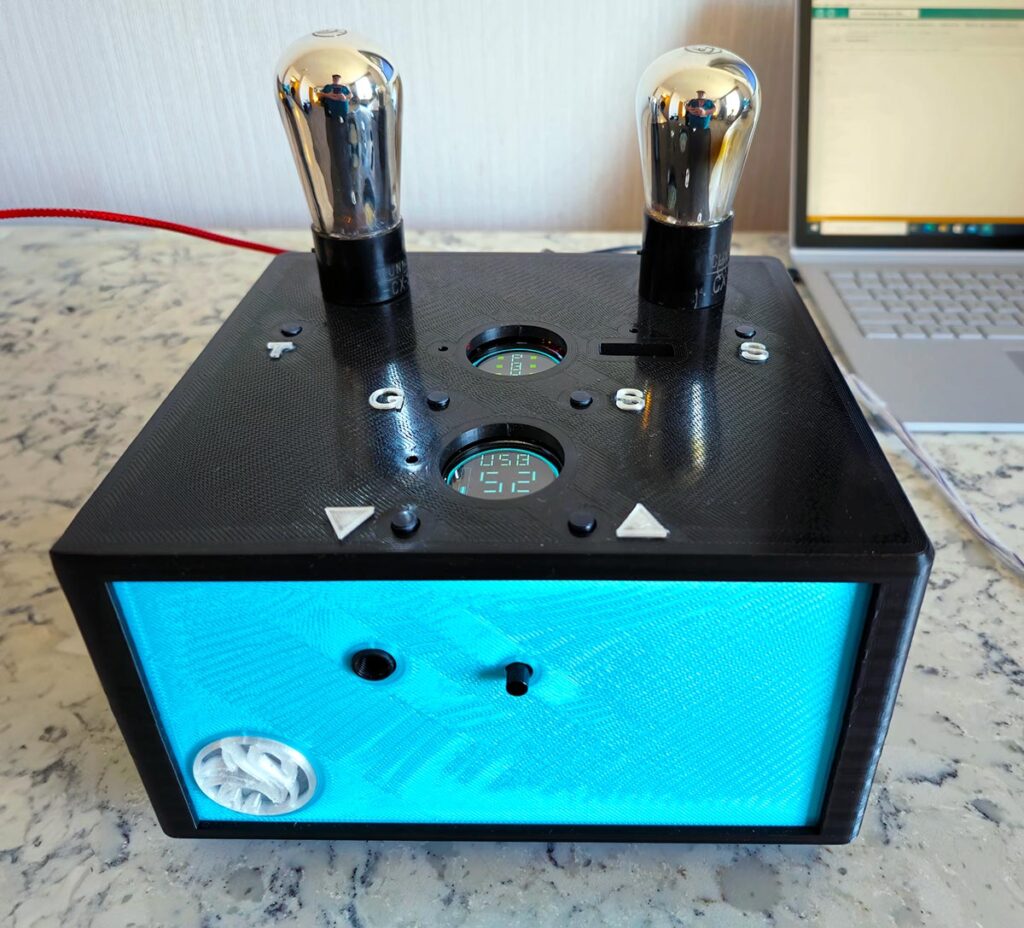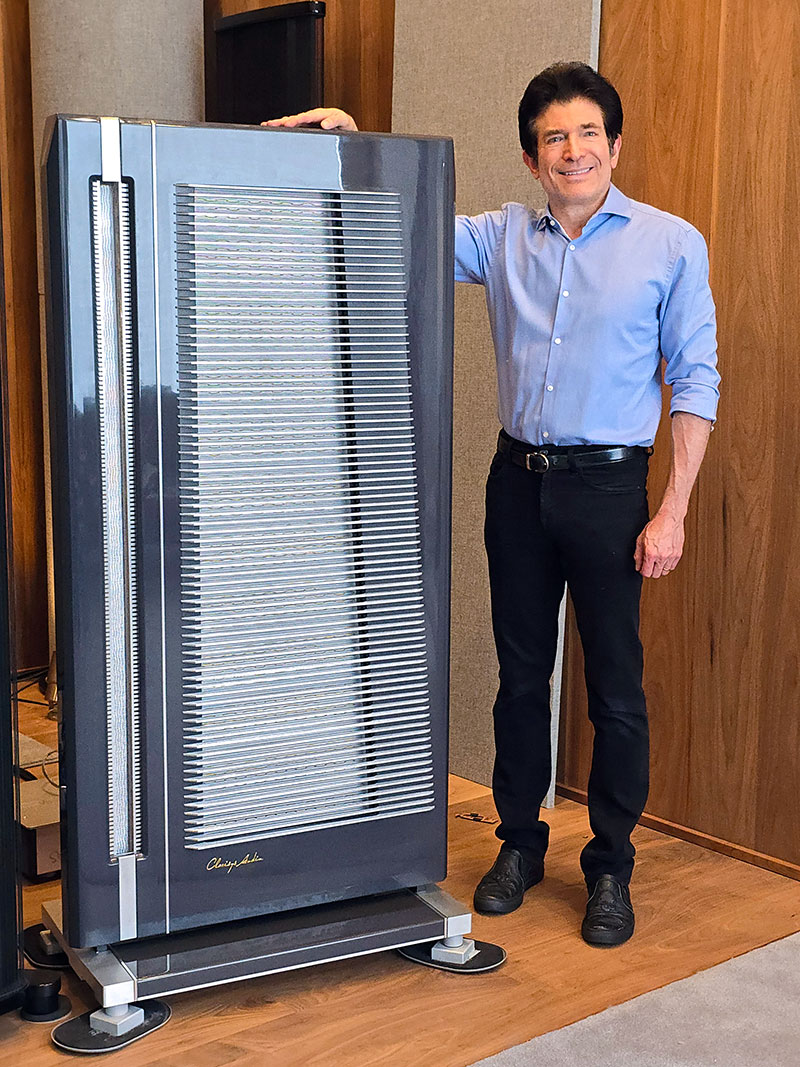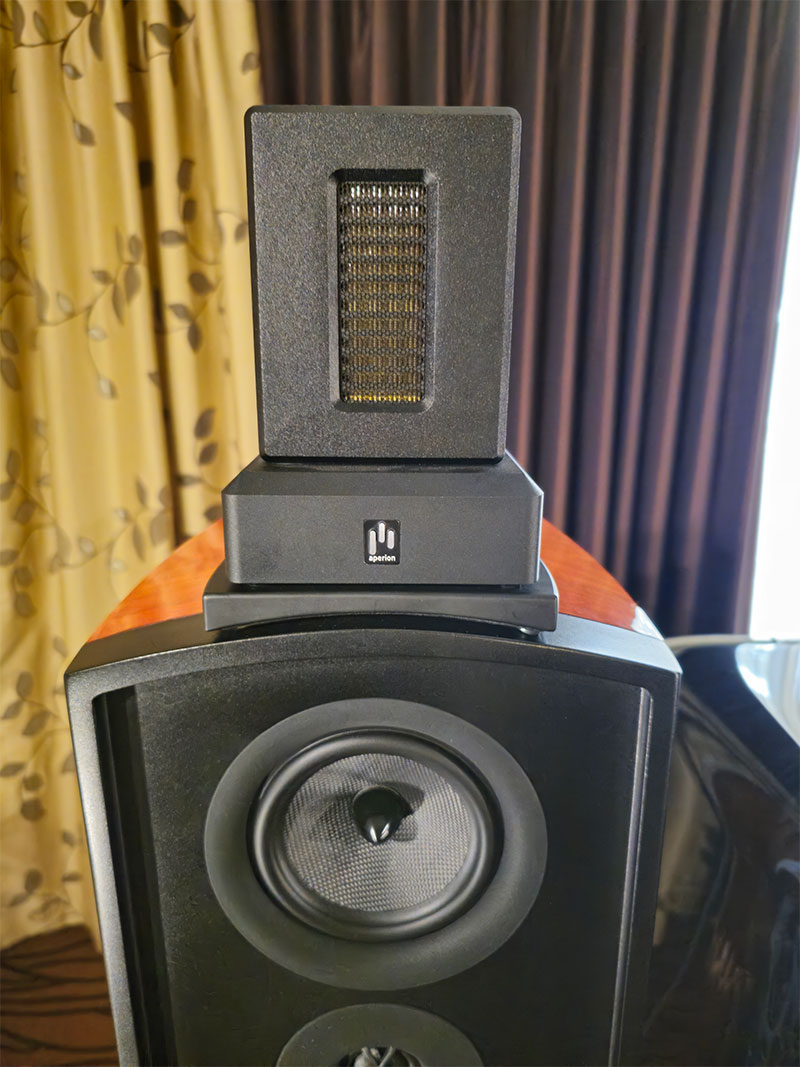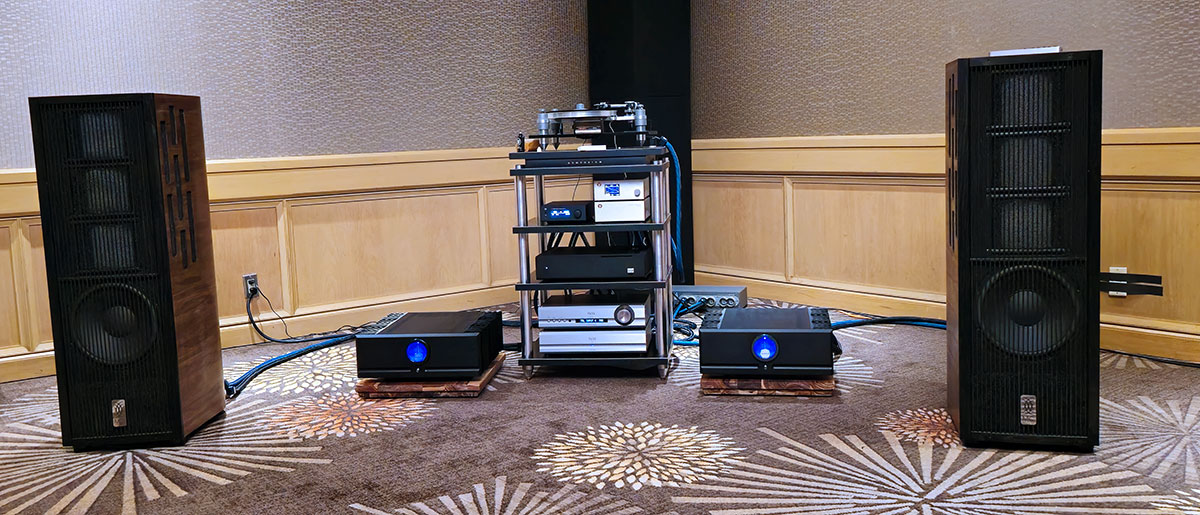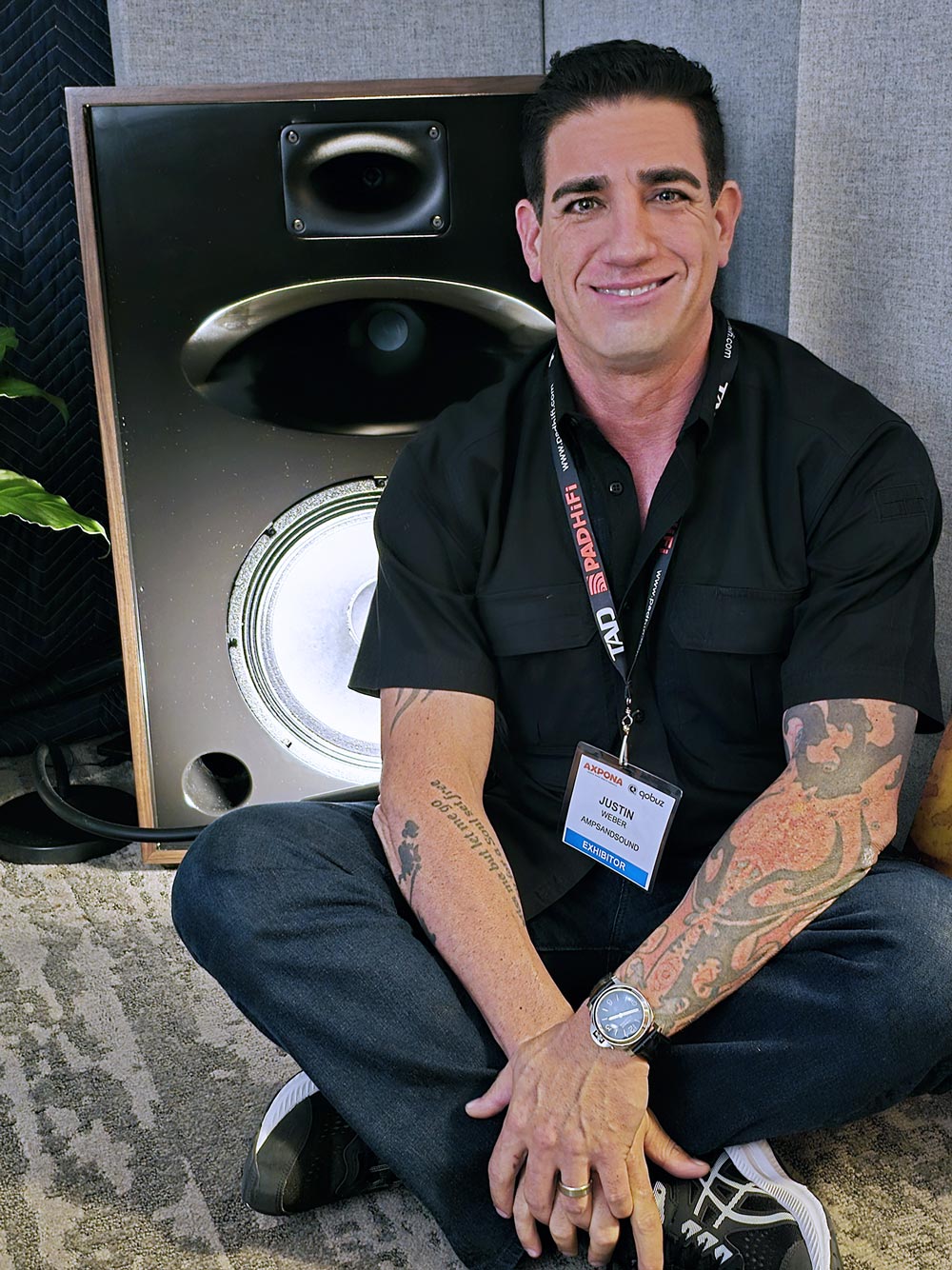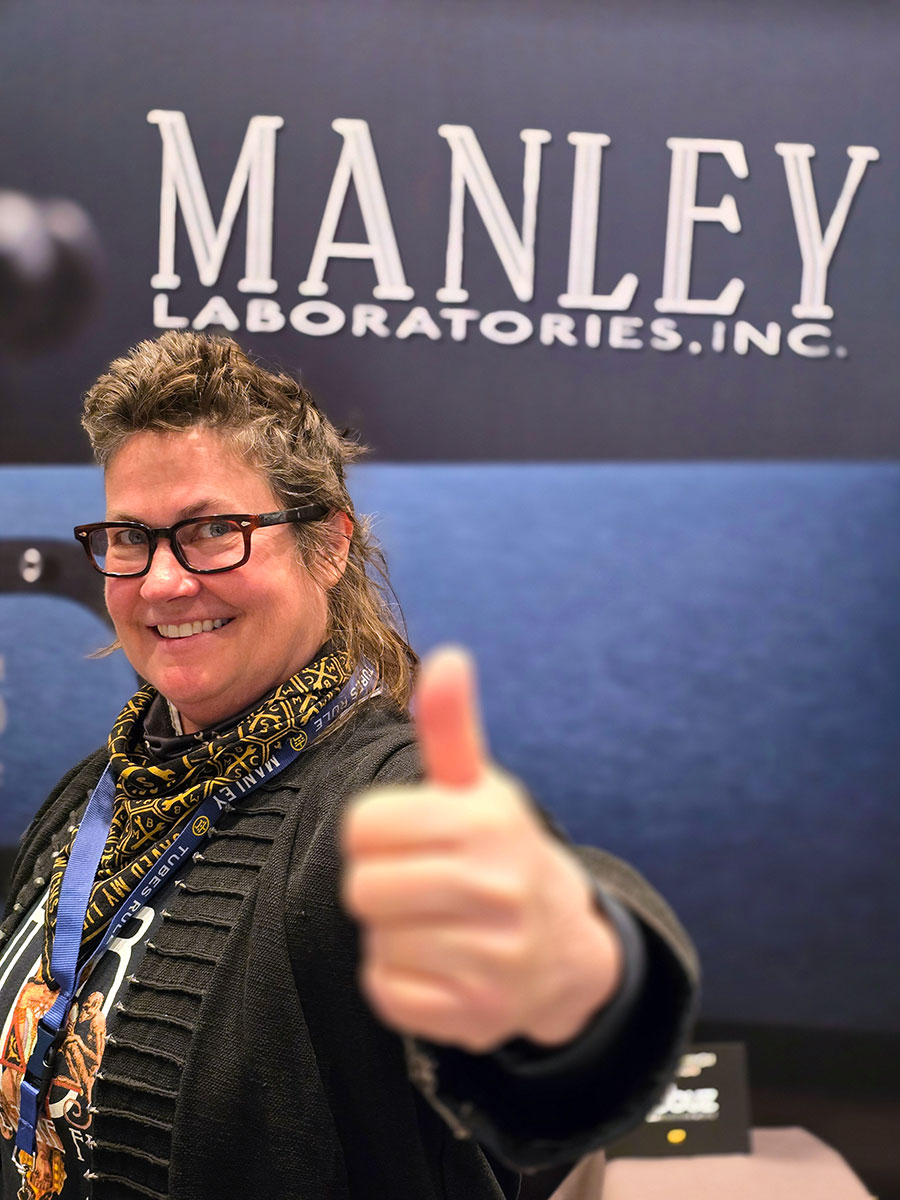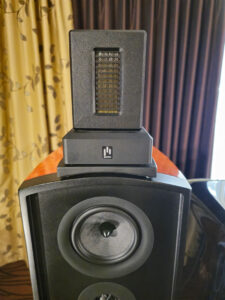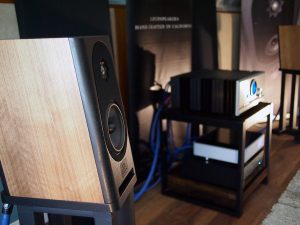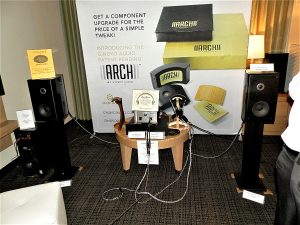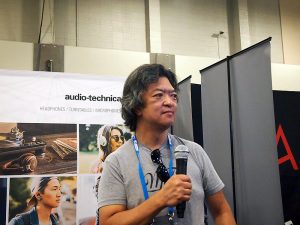Some of the most fun to be had at AXPONA was discovering fresh new ideas and technology. Never have I ever encountered a complete 3D printed horn system (with bass cabinets), or software algorithm-controlled tube equipment. Yet, this is exactly what Tony Crocker of Swan Song Audio delivered and more.
Who is Tony and Swan Song Audio?
Tony builds bespoke headphones and electronics in Tulsa Oklahoma. Coming solidly out of Maker culture, he builds headphones from a combination of 3D printing and tone woods. Word on the Internet is that they are well worth your time.
One of Swan Song's freshest bespoke headphone designs (Photo by Tony Crocker)
What Tony set out to do at this AXPONA was to create a one-of-a-kind audio "future-rama" showcase of the power of 3D printing, battery power, algorithmic control of vacuum tubes with a unique voltage gain volume control. Tony's goal was not to sell equipment, but to demonstrate how the technology he developed for headphone systems could be used in a speaker setup. It's rare that you see a pure concept presentation at an audio show, and I absolutely applaud the effort.
The first thing I noticed when I came into his room were the bright blue horns perched on the credenza, next the two large octagon shaped speaker cabinets for the bass and midrange drivers. Then you see the matching small, bright blue electronics with some unique copper heatsinks. The system was set up on the long wall, and Tony was demoing a variety of music. The music lit up the room. In my listening notes I used the word clarity in four different lines. I heard some of that same open liquid clarity that I hear when 300B amps are pumping out the tunes. It was very enjoyable, and Tony obviously knows something about audio.
But it is the technology that really intrigued me.
3D Printing and Maker Culture
3D printing is something that has been slowly coming into its own in audio. I had a pair of Mr Speakers Alpha Dog headphones in 2014 that claimed to be the first use of 3D printing in headphones. Tony is using high density materials to create entire cases, horns, and bass cabinets. I copped a feel on the equipment, and it was much more solid, rigged, and heavy than I would expect from the materials. The bass cabinets felt as solid as other speaker cabinets I have encountered. Maker Culture has enabled anyone with an idea to work on getting just the right horn flare or perfecting the porting for a bass cabinet without prohibitively expensive tooling machines. The result, while unique looking to say the least, was very nice to listen to.
The following are Tony's comments about his process and how Maker Culture has influenced his designs.
"I follow videos from Rickey Impey and CNC kitchen. Both sources help with setup issues and better printing methods. Besides this I receive several texts from my brother who is part of the Maker community. My brother got me into printing several years ago. His initial prints were focused on typical Maker curios. With his help and my Computer Aided Design we were able to scale up and improve the prints to build enclosures, headphones, and speakers. I receive regular emails from Matter Hackers and Creality. Both help with filament and equipment choices.
As to the actual designs, they are my own based on the application. It is a form follows function approach. I draw inspiration from watch manufacturers such as LeCoultre, Vacheron, Breitling, Glashutte, and Charriol. As well as Crazy Pig Jewelers in London. All of which I have in my collection."
2 Way Horn/Omni Speakers
The demo system was installed in a listener's home after the show. (Photo by Tony Crocker)
Those bright blue horns did sing, and the omni was very spacious and went deep in the custom cabinet. More info from Tony:
"The speaker is a two-way design with the crossover between the horn and the omni is 500Hz. The speakers and horns were printed from PLA Tough and PLA Silk. The PLA Silk is good for colors, but not for strength. The black PLA Tough is good for strength.
I am rolling out a concept I call color line. The Color line combines functional first design of Bauhaus with a bit of Charriol color. An all-purple enclosure can be a bit much. A black PLA tough enclosure with textured sides and a line of PLA silk color makes the color line more interesting while at the same time making the part stronger.
The other material was lasered composite aluminum. A combination of aluminum and polymer layers create a light weight but strong material that does not need painting
The walnut panels were lasered solid walnut. I do not use veneers. None of my prints have any finishing. No sanding or painting. They are as they came off the printer. This approach means printing is slow to avoid high scrap rates?"
Tony discusses the bass cabinets
"The omni cabinet can be thought of as four parts.
- Top and bottom lasered composite aluminum
- Center superstructure 3D printed PLA Tough
- Solid walnut panels
- Outer panels made from 3D printed PLA Silk.
The removal of the wood and outer panels protects them during transit. It also allows the wood to be changed out to change the tonality of the speaker."
Front End - The 01A
The 01A front-end acts as tube preamp and DAC. Swan Song calls this an Alpha and Omega product because he combines the first commercial triode tube—the 01, with modern processing, and algorithmic intelligence.
This is where things get really interesting.
It is battery powered. The system measures the tubes on startup and adjusts them to always be at their ideal operating point. This means there is no need to match left and right channel tubes parameters will always be synced. The processor constantly adjusts gain and other parameters, which greatly extends the life of the tubes. Tony describes the circuit:
"The 01A was running two 301A tubes from the 1920's. 301A is Cunningham. 201A is RCA. 401A is Deforest. All are the 01a family. The 01A is the first commercial triode tube. All tubes trace their roots to the 01A. It is the Alpha part of the Alpha Omega symbols printed on the DAC, preamp, and headphone amp enclosure. The Omega refers to the usage of modern microprocessors to run algorithms.
01A is the fourth iteration in the Enchantment line. This iteration takes the microprocessors from a time-based to a task-based approach. I work exclusively with pre-WWII tubes. They include the 01a, 26, 56, and 71 from the 1920s and 30s. I also work with the following high frequency radar and transmission tubes 1T4, 6AF4, 2C22, and 955.
All these tubes are exotic because they are hard to work with. Data sheets provide limited information. The tubes take the data sheet as a suggestion not a rule. During Covid lockdown I acquired large caches of tubes. I then studied the tubes and documented them. I began by testing them on my Signal Corps 177A. Then I built a microprocessor-controlled preamplifier that could run all the tubes. I ran the tubes under various conditions, studied and documented them some more. What I learned was how the tubes would behave under the various conditions and stages in their life cycle. This allowed me to develop algorithms used by the microprocessor to meet the tube where it is and not force it into a place where it does not want to be.
The 01A process takes several minutes at startup. The tube is exercised and given a series of tasks. Based on the tube's performance, the tube is placed in a spot where it is happy, which includes all the tube parameters not just the bias. Part of the testing is a gain test that is used by the processor to set the left/right balance. Some of these tubes have a soft vacuum and may get air in them. This causes them to get upset and make noises. The microprocessor deals with this through a series of hard limits and deviation limits. Deviation means moving around but not breaking the limit. If a tube is being naughty, it is put into a time out. The microprocessor switches into solid state mode and you keep listening without knowing anything happened. The tube enters a period of low heater voltage before going through the tests all over again. Once the tube is more agreeable, the operating parameters are reestablished, gain is calculated, and the tubes are put back into service. In short, the processor takes care of the tube. This approach allows me to extend the life of the by tubes 50%.
Enchantment is in the process of its fifth iteration and production readiness. Release dates late 2024 or early 2025. Price range around $15K USD."
A Gain Stage Volume Control
This is not your grandfather's scratchy old volume attenuation pot. The volume is processor controlled and handled by a current to voltage gain circuit with 128 steps. Tony explains:
"I have built or used every volume control available. A volume control, by definition, introduces distortion. After much testing of distortion levels caused by various components, I was able to select the lowest distortion components and values. This allowed me to build several iterations of an i2V volume control. It works by you telling the processor what volume you would like, 0 through 128. The processor talks to other low noise solid-state parts that use discrete resistors to convert the audio signal into current and then gain the voltage up to appropriate volume. When done right this does not affect the harmonic signature of the tube. That signature once introduced remains with the signal. The i2V is very quiet with a distortion rate of .001%."
Battery Power
In this demo all the electronics were battery powered, which is probably really smart in hotel show conditions, where dirty power is often the culprit for less than spectacular sonics. I asked Tony about the battery technology he uses:
"I design all my gear to run at least eight hours before requiring a recharge. Batteries are LIPO and range from 350mA hours to 10amp hours. Charging is done at a level of 10 to 20% of the battery capacity using standard wall-warts or lap top bricks. This low charge rate takes longer but extends the battery life. I have had battery products running for more than three years now with no sign of battery degradation.
I can build standard power supplies too. At AXPONA 2021 I demonstrated Enlightenment with over 400dB of power filtering per supply! But there will also be some level of noise. With batteries I need some high frequency filtering. But I am immune to mains noise. The customer no longer needs power conditioning or expensive power cords. Batteries provide a low noise floor that other power supplies and conditioning cannot. The music is cleaner, and you can listen at a lower volume level."
Dual Mono Amplifiers
Fitting into the future punk aesthetic were two small blue boxes with copper fins exposed which are also battery powered and run Tony's optimized Class A diamond buffer circuit. They need those fins as they are very hot to touch while they output 11-watts per side. Did I burn myself touching them? Almost! Those 11-watts were plenty to drive the speakers, they sounded dynamic and effortless. This design also uses a real-time processor to monitor and correct the wattage real-time.
Cabling
Tony's cabling is nothing to scoff at, being built from 9-strand twisted Argentium silver with marine grade heat shrink and terminated with pure copper ends. Capacitance is 11pf per foot. I asked Tony about the type of silver he uses and the design:
"I have been making my own cables for over 10 years. I have worked in copper, gold, silver, sterling silver, and Argentium silver. Argentium is a brand name for a silver that has been further refined and mixed with germanium, as in solid-state before silicon. The result is a silver the does not tarnish nor has the harshness associated with 99.9% purity silver. The purity is 94.0% silver versus 92.5% for sterling silver.
I have my own jig and winding machine. I simultaneously twist three sets of three strand Argentium cables that are combined into a nine-strand twist. The strands are not separately insulated. The twist is such that the cable will retain flexibility but not unravel.
I used a marine grade clear heat shrink made from polyolefin. The cables were terminated with solid copper connectors. I am not a fan of gold-plated brass. The speaker cables were 14awg and the RCA 16awg. Both cables were a side-by-side configuration with 11 picofarads per foot capacitance."
To sum up, this one room displayed more forms of innovation than the rest of the floor of demo systems at the show. I hope this creativity will spread to other engineers and designers in audio while being a shot in the arm for the ennui that becomes too common in HiFi.
A closeup of the horn flare




